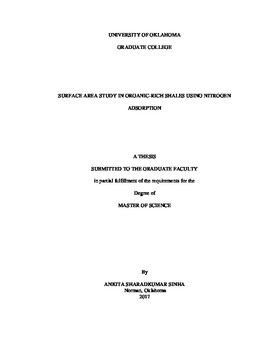| dc.description.abstract | Low-pressure nitrogen adsorption technique was used to investigate the specific surface area and pore size distributions and controlling factors for 11 wells from seven different shale formations with varying thermal maturity, organic matter content and clay content. The pore structure of these shales and isolated kerogen were studied using nitrogen adsorption and SEM imaging. We show that low maturity samples from the immature window have very low specific surface areas ranging from 1.13 to 6.91 m2/g; in contrast, samples in later stages of maturity have higher specific surface area ranging from 2.14 to 41.51 m2/g. In the organic-rich shales, incorrect estimation of surface area leads to erroneous quantification of the pore size distribution. Surface areas measured in the “as-received” (before solvent extraction) state did not show a strong dependence on total clay or organic content although these two components have high surface areas. Underestimation of surface area is due to the non-removal of residual water and soluble hydrocarbons, including bitumen. We tested this proposal by extracting the shale samples using an 4:1 toluene:methanol azeotrope at 63.8°C in a standard Soxhlet extractor. Geochemistry and pore network attributes before and after removal of soluble hydrocarbons were characterized. Results show that the TOC, S1, S2 of the extracted samples decrease significantly and the extraction process greatly increases the specific surface area and pore volume of the samples. The increase in the specific surface area is maximum in the immature window having an average increase of 175% and minimum in the gas window having an average increase of 15%. We determined an empirical relationship between surface area, TOC and clay content for various maturity windows. Our results indicate that the specific surface area is a function of maturity and gas adsorption increases with organic pore generation as an outcome of maturation. Grain density measurements pre- and post-solvent extraction were used to determine the “extra-porosity” associated with soluble bitumen and residual hydrocarbons in varying maturity window and then correlated with TOC. Solvent extraction increased porosity by an average of 93% in the immature window, 39% in oil window, 19% in condensate window, and 10% in the gas window. We show for isolated kerogen, the low-maturity samples have very few nanopores in addition to having very low specific surface areas ranging from 3.74 to 9.24 m2/g. In contrast, nanopores are abundant in the mature to over mature kerogen, leading to high specific surface areas in range of 15.81 to 41.96 m2/g. | en_US |
